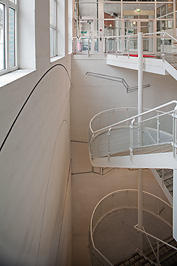Sculpture? Drawing? Architecture?
In Kjell Varvin’s installation artwork the sculpture grows out of the wall. It has an architectonic function, as a supplement to the room. Part of it is painted, other parts sculpted.
Main content
With his lines and bars Varvin relates to what is often described as a modernist style. But he violates one of the most important principles of modernism: the uniqueness of the material. Varvin’s sculpture slides from painted lines to sculpted steel and back again almost imperceptibly. The sculpture exceeds the borders between the media, and the boundaries of the room. It's a game of geometry, a light self-ironic tribute to the great modernist installation artists. As Varvin himself puts it: "I'm building. One piece fits into the other”. The work looks orderly and planned, but is the result of a chaotic process.
The drawing made three-dimensional is typical of Kjell Varvin. His sculptures challenge what we think of as stability. They can be considered as an analysis of chaos, or as a recognition achieved through straying wide.
Kjell Varvin (1939 -) is an installation artist. He has made a series of public artworks. Notable are the Lørenskog Culture House, the Victoria Terrace at the Foreign Ministry and the NEPA building in Beijing. Varvin’s pieces can be found in the National Gallery, the Arts Council Norway and the Central Academy of Arts in Beijing.
NORA SØRENSEN VAAGE





